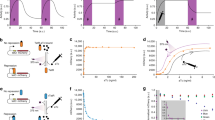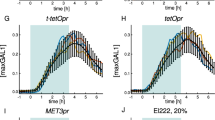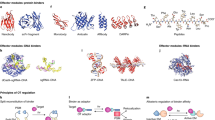Abstract
Gene circuits are dynamical systems that regulate cellular behaviors, often using protein signals as inputs and outputs. Here we have developed an optogenetic 'function generator' method for programming tailor-made gene expression signals in live bacterial cells. We designed precomputed light sequences based on experimentally calibrated mathematical models of light-switchable two-component systems and used them to drive intracellular protein levels to match user-defined reference time courses. We used this approach to generate accelerated and linearized dynamics, sinusoidal oscillations with desired amplitudes and periods, and a complex waveform, all with unprecedented accuracy and precision. We also combined the function generator with a dual fluorescent protein reporter system, analogous to a dual-channel oscilloscope, to reveal that a synthetic repressible promoter linearly transforms repressor signals with an approximate 7-min delay. Our approach will enable a new generation of dynamical analyses of synthetic and natural gene circuits, providing an essential step toward the predictive design and rigorous understanding of biological systems.
This is a preview of subscription content, access via your institution
Access options
Subscribe to this journal
Receive 12 print issues and online access
$259.00 per year
only $21.58 per issue
Buy this article
- Purchase on Springer Link
- Instant access to full article PDF
Prices may be subject to local taxes which are calculated during checkout





Similar content being viewed by others
References
Bennett, M.R. et al. Metabolic gene regulation in a dynamically changing environment. Nature 454, 1119–1122 (2008).
Mettetal, J.T., Muzzey, D., Gómez-Uribe, C. & van Oudenaarden, A. The frequency dependence of osmo-adaptation in Saccharomyces cerevisiae. Science 319, 482–484 (2008).
Wei, P. et al. Bacterial virulence proteins as tools to rewire kinase pathways in yeast and immune cells. Nature 488, 384–388 (2012).
Muzzey, D., Gómez-Uribe, C.A., Mettetal, J.T. & van Oudenaarden, A. A systems-level analysis of perfect adaptation in yeast osmoregulation. Cell 138, 160–171 (2009).
Tan, C. et al. The inoculum effect and band-pass bacterial response to periodic antibiotic treatment. Mol. Syst. Biol. 8, 617 (2012).
Hersen, P., McClean, M.N., Mahadevan, L. & Ramanathan, S. Signal processing by the HOG MAP kinase pathway. Proc. Natl. Acad. Sci. USA 105, 7165–7170 (2008).
Milias-Argeitis, A. et al. In silico feedback for in vivo regulation of a gene expression circuit. Nat. Biotechnol. 29, 1114–1116 (2011).
Uhlendorf, J. et al. Long-term model predictive control of gene expression at the population and single-cell levels. Proc. Natl. Acad. Sci. USA 109, 14271–14276 (2012).
Tabor, J.J., Levskaya, A. & Voigt, C.A. Multichromatic control of gene expression in Escherichia coli. J. Mol. Biol. 405, 315–324 (2011).
Levskaya, A. et al. Synthetic biology: engineering Escherichia coli to see light. Nature 438, 441–442 (2005).
Lutz, R. & Bujard, H. Independent and tight regulation of transcriptional units in Escherichia coli via the LacR/O, the TetR/O and AraC/I1–I2 regulatory elements. Nucleic Acids Res. 25, 1203–1210 (1997).
Pédelacq, J.-D., Cabantous, S., Tran, T., Terwilliger, T.C. & Waldo, G.S. Engineering and characterization of a superfolder green fluorescent protein. Nat. Biotechnol. 24, 79–88 (2006).
Alon, U. An Introduction to Systems Biology: Design Principles of Biological Networks (CRC Press, 2007).
Yokobayashi, Y., Weiss, R. & Arnold, F.H. Directed evolution of a genetic circuit. Proc. Natl. Acad. Sci. USA 99, 16587–16591 (2002).
Ang, J., Ingalls, B. & McMillen, D. Probing the input-output behavior of biochemical and genetic systems system identification methods from control theory. Methods Enzymol. 487, 279–317 (2011).
Levine, J.H., Lin, Y. & Elowitz, M.B. Functional roles of pulsing in genetic circuits. Science 342, 1193–1200 (2013).
McAdams, H.H. & Shapiro, L. A bacterial cell-cycle regulatory network operating in time and space. Science 301, 1874–1877 (2003).
Bell-Pedersen, D. et al. Circadian rhythms from multiple oscillators: lessons from diverse organisms. Nat. Rev. Genet. 6, 544–556 (2005).
Young, J.W., Locke, J.C.W. & Elowitz, M.B. Rate of environmental change determines stress response specificity. Proc. Natl. Acad. Sci. USA 110, 4140–4145 (2013).
El-Samad, H., Kurata, H., Doyle, J.C., Gross, C.A. & Khammash, M. Surviving heat shock: control strategies for robustness and performance. Proc. Natl. Acad. Sci. USA 102, 2736–2741 (2005).
Vishnoi, M. et al. Triggering sporulation in Bacillus subtilis with artificial two-component systems reveals the importance of proper Spo0A activation dynamics. Mol. Microbiol. 90, 181–194 (2013).
Levine, J.H., Fontes, M.E., Dworkin, J. & Elowitz, M.B. Pulsed feedback defers cellular differentiation. PLoS Biol. 10, e1001252 (2012).
Kuchina, A. et al. Temporal competition between differentiation programs determines cell fate choice. Mol. Syst. Biol. 7, 557 (2011).
Ray, J.C.J., Tabor, J.J. & Igoshin, O.A. Non-transcriptional regulatory processes shape transcriptional network dynamics. Nat. Rev. Microbiol. 9, 817–828 (2011).
Kalir, S. et al. Ordering genes in a flagella pathway by analysis of expression kinetics from living bacteria. Science 292, 2080–2083 (2001).
Temme, K. et al. Induction and relaxation dynamics of the regulatory network controlling the type III secretion system encoded within Salmonella pathogenicity island 1. J. Mol. Biol. 377, 47–61 (2008).
Cardinale, S., Joachimiak, M.P. & Arkin, A.P. Effects of genetic variation on the E. coli host-circuit interface. Cell Rep. 4, 231–237 (2013).
Arkin, A.P. A wise consistency: engineering biology for conformity, reliability, predictability. Curr. Opin. Chem. Biol. 17, 893–901 (2013).
Canton, B., Labno, A. & Endy, D. Refinement and standardization of synthetic biological parts and devices. Nat. Biotechnol. 26, 787–793 (2008).
Zaslaver, A. et al. Just-in-time transcription program in metabolic pathways. Nat. Genet. 36, 486–491 (2004).
Temme, K., Zhao, D. & Voigt, C.A. Refactoring the nitrogen fixation gene cluster from Klebsiella oxytoca. Proc. Natl. Acad. Sci. USA 109, 7085–7090 (2012).
Rockwell, N.C., Martin, S.S., Feoktistova, K. & Lagarias, J.C. Diverse two-cysteine photocycles in phytochromes and cyanobacteriochromes. Proc. Natl. Acad. Sci. USA 108, 11854–11859 (2011).
Jaubert, M. et al. Control of peripheral light-harvesting complex synthesis by a bacteriophytochrome in the aerobic photosynthetic bacterium Bradyrhizobium strain BTAi1. J. Bacteriol. 190, 5824–5831 (2008).
Shimizu-Sato, S., Huq, E., Tepperman, J.M. & Quail, P.H. A light-switchable gene promoter system. Nat. Biotechnol. 20, 1041–1044 (2002).
Müller, K. et al. Multi-chromatic control of mammalian gene expression and signaling. Nucleic Acids Res. 41, e124 (2013).
Levskaya, A., Weiner, O.D., Lim, W.A. & Voigt, C.A. Spatiotemporal control of cell signalling using a light-switchable protein interaction. Nature 461, 997–1001 (2009).
Toettcher, J.E., Gong, D., Lim, W.A. & Weiner, O.D. Light-based feedback for controlling intracellular signaling dynamics. Nat. Methods 8, 837–839 (2011).
Toettcher, J.E., Weiner, O.D. & Lim, W.A. Using optogenetics to interrogate the dynamic control of signal transmission by the Ras/Erk module. Cell 155, 1422–1434 (2013).
Miyazaki, K. MEGAWHOP cloning: a method of creating random mutagenesis libraries via megaprimer PCR of whole plasmids. Methods Enzymol. 498, 399–406 (2011).
Salis, H.M., Mirsky, E.A. & Voigt, C.A. Automated design of synthetic ribosome binding sites to control protein expression. Nat. Biotechnol. 27, 946–950 (2009).
Gibson, D.G. et al. Enzymatic assembly of DNA molecules up to several hundred kilobases. Nat. Methods 6, 343–345 (2009).
Tabor, J.J. et al. A synthetic genetic edge detection program. Cell 137, 1272–1281 (2009).
Engler, C., Kandzia, R. & Marillonnet, S. A one pot, one step, precision cloning method with high throughput capability. PLoS ONE 3, e3647 (2008).
Acknowledgements
This research was supported by the US National Science Foundation Biotechnology, Biochemical, and Biomass Engineering (BBBE) program (EFRI–1137266) and the Office of Naval Research MURI programs (N000141310074). L.A.H. was supported by the US National Aeronautics and Space Administration Office of the Chief Technologist's Space Technology Research Fellowship (NSTRF) (NNX11AN39H). We thank S. Schmidl (Rice University) for his contribution of the pPCBSE plasmid.
Author information
Authors and Affiliations
Contributions
J.J.T. and E.J.O. conceived of the project, and J.J.T. supervised the project. E.J.O., L.A.H., B.P.L. and R.S. designed and performed experiments. E.J.O. and B.P.L. designed and constructed plasmids. E.J.O. designed and constructed the LTA, analyzed data, constructed the model and developed the light program sequence optimization algorithm. J.J.T. and E.J.O. wrote the manuscript.
Corresponding author
Ethics declarations
Competing interests
The authors declare no competing financial interests.
Supplementary information
Supplementary Text and Figures
Supplementary Figures 1–18, Supplementary Tables 1–7 and Supplementary Notes 1–12 (PDF 3922 kb)
Supplementary Software
Python scripts to perform flow cytometry file extraction and analysis, produce model simulations of gene expression output, fit models to gene expression data and compute light inputs that drive gene expression output to follow a reference signal. (ZIP 1580 kb)
Rights and permissions
About this article
Cite this article
Olson, E., Hartsough, L., Landry, B. et al. Characterizing bacterial gene circuit dynamics with optically programmed gene expression signals. Nat Methods 11, 449–455 (2014). https://doi.org/10.1038/nmeth.2884
Received:
Accepted:
Published:
Issue Date:
DOI: https://doi.org/10.1038/nmeth.2884
This article is cited by
-
Bifunctional optogenetic switch for improving shikimic acid production in E. coli
Biotechnology for Biofuels and Bioproducts (2022)
-
An adaptive tracking illumination system for optogenetic control of single bacterial cells
Applied Microbiology and Biotechnology (2022)
-
A light tunable differentiation system for the creation and control of consortia in yeast
Nature Communications (2021)
-
Harnessing the central dogma for stringent multi-level control of gene expression
Nature Communications (2021)
-
A tunable dual-input system for on-demand dynamic gene expression regulation
Nature Communications (2019)



